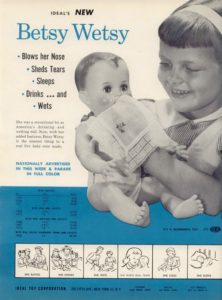The oldest sex toy archeologists have found is a Paleolithic polished stone phallus from around 29,000 BC, discovered in a cave in southwestern Germany in 2005. Sex toys are us.

It took 30,000 years for the machine age to catch up with the stone age and add motion to the sex toy. Then in 1869 a steam-powered vibrator called The Manipulator was invented by Dr. George Taylor. With the steam engine in a separate room from the patient, reports say The Manipulator fell out of fashion because doctors couldn’t take it on house calls.
Another doctor, Joseph Mortimer Granville invented an electric vibrator in 1883 as a tool to treat men for headaches, sexual dysfunction, irritability, indigestion, and constipation. Similarly, a Dr. Gerald Macaura invented and patented in 1902, the Pulsocon, a curiosity which one may still find for sale online. The Pulsocon was a low cost, hand-cranked, vibrating protuberance intended to help women loosen up and improve their blood circulation. Dr. Macaura spent a year in prison for his claim that the Pulsocon had curative effects.
In 1915, the American Medical Association called the vibrator “a delusion and a snare” redirecting the market away from healthcare toward home appliances and cosmetics. As such, the vibrator was the fifth household appliance to be electrified, ten years before the vacuum cleaner and the iron. Sold to women through ladies’ magazines, a vibrator could be ordered for $5 from the Sears catalog. With promises to reverse aging and improve moods, masturbation was never mentioned in the ads. But there were winks like “invented by a woman who knows a woman’s needs.”
By 1956 Sears was producing its own vibrator. An ad for the Arnold vibrator claimed, “Every woman can have a faultless complexion and youthful, finely proportioned figure. There is no further need of powder, paint, pads or other deceptions.”
Then the Madison Avenue Mad Men got ahold of the idea, inspired by one Betty Dodson, who began teaching women-only masturbation workshops in the late 1960s, and finally, the Hitachi Magic Wand, penetrated global markets.
In response the state of Texas passed the Obscene Device Law in 1973, prohibiting any device designed or marketed primarily for the stimulation of human genital organs. As a result, vibrators were sold as personal massagers.
To get past obscenity laws, in Japan factories made vibrators that looked like toys, brightly colored Beavers, Kangaroos, and Turtles with phallic extensions and ticklers. But it was the Rabbit that became the animal of choice, thanks to one “Sex and the City” episode in 1998.
That same year Alabama passed a law outlawing sex toys, punishable by heavy fines and even jail time, making the argument that women do not have a “fundamental or constitutional right” to items used for sexual pleasure.
In 2008, a judge declared the Texas anti-vibrator law from 1973, which included a prohibition against owning more than six dildos, to be unconstitutional and unenforceable. But the threat dangles.
In 2018, sex toy manufacturer Lora DiCarlo (a company, not a person) won the Robotics Innovation Award from the Consumer Electronics Show (CES). Then a month later in 2019 the award was rescinded because the product, an electronic vibrator that uses micro-robotics to give women pleasure, was retroactively deemed by executives to be profane, immoral, and obscene. Their words. After much outrage and media coverage the award was reinstated.
In 2020 the global market for sex toys was estimated to be $35 billion. Unsurprisingly, also in 2020, the Consumer Electronics Show welcomed sex tech companies under the Health & Wellness product category.
According to market studies, as of 2021, 52% of American women have used a vibrator. And that’s just the ones who admit it. Because, you know, double standards.
By 2026 the global sex toy market is predicted to reach $50 billion with growth driven by smart vibrators configured for male and female genitalia that can be programmed, remote-controlled, and synched to music, all on your smart phone. Internet-controlled vibrators have the advantage of being able to change the settings while the device is inserted. His and hers models have partner controls enabling spontaneous sexual interactions over the phone, anytime, from anywhere in the world.
So, the smart vibrator is social media. With phone-based sex apps operating vibrators, every orgasm will have a user ID, an IP address, a GPS location, a date and time, and a cluster of personalized data including settings and preferences, maybe even duration and a score. When two people use the app together, there will be two sets of matching data. Imagine the divorces. Smart vibrators enable hook-ups and prostitution in the metaverse. Is virtual sex cheating? Pretty Woman on porn hub says if you want to have sex with me, buy my app.
Monetizing sex is the oldest business in the world. It’s always been a game, but now we have stats and new forums. Think Peloton. What could go wrong? Ask the women deleting pregnancy and menstruation apps from their phones since the June 24, 2022, Supreme Court decision to take away a woman’s right to self-determination. Sex is a game until the government occupies your uterus. Then it’s life threatening. The hypocrisy is infinite.
~ : ~



Ya ‘nailed’ it, Bil. Serve the Self